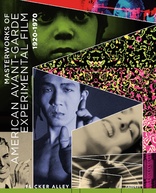Masterworks of American Avant-Garde Experimental Film 1920-1970 Blu-ray Movie
HomeMasterworks of American Avant-Garde Experimental Film 1920-1970 Blu-ray Movie 
Blu-ray + DVDFlicker Alley | 1920-1970 | 37 Movies | 372 min | Not rated | Sep 29, 2015
Movie rating
6.9 | / 10 |
Blu-ray rating
| Users | 0.0 | |
| Reviewer | 4.5 | |
| Overall | 4.5 |
Overview
Masterworks of American Avant-Garde Experimental Film 1920-1970 (1920-1970)
Flicker Alley and the Blackhawk Films® Collection, in collaboration with Filmmakers Showcase, are proud to present Masterworks of American Avant-garde Experimental Film 1920-1970 in a 4-disc Blu-ray/DVD Combo Edition. This breathtaking collection includes 37 films, restored to pristine high-definition, from some of the foremost experimental filmmakers of the 20th century. Commencing in 1920 with Charles Sheeler and Paul Strand’s creative collaboration on Manhatta, successive generations of experimental filmmakers and artists have worked in collaboration or alone to create a cinema capable of expressing dynamic unspoken concepts in totally abstract visual terms.
Starring: Maya Deren, Chao Li ChiDirector: James Broughton, Charles Sheeler, Paul Strand, Marie Menken, Jonas Mekas
| Short | 100% |
Specifications
Video
Video codec: MPEG-4 AVC
Video resolution: 1080p
Aspect ratio: 1.34:1
Original aspect ratio: 1.37:1
Audio
Music: DTS-HD Master Audio 2.0
Subtitles
English
Discs
50GB Blu-ray Disc
Four-disc set (2 BDs, 2 DVDs)
DVD copy
Playback
Region free
Review
Rating summary
| Movie | 4.5 | |
| Video | 4.0 | |
| Audio | 5.0 | |
| Extras | 3.5 | |
| Overall | 4.5 |
Masterworks of American Avant-Garde Experimental Film 1920-1970 Blu-ray Movie Review
Reviewed by Dr. Svet Atanasov October 28, 2015"Masterworks of American Avant-Garde Experimental Film 1920-1970" arrives on Blu-ray courtesy of independent distributors Flicker Alley. Included in the collection are thirty-seven restored films with original and newly composed music. The release also arrives with a 28-page illustrated booklet featuring curator, filmmaker, and film historian Bruce Posner's essay "Let the Eyes Have It". Region-Free.
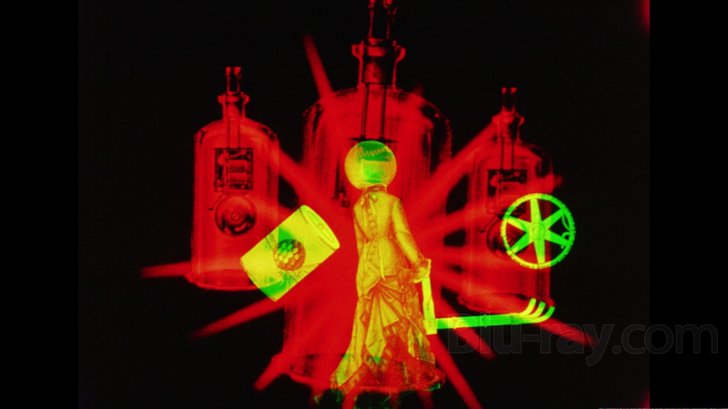
The two-disc collection features 37 vintage short films, some of which have been recently restored in 2K. Many of the films are silent but are presented with new music by acclaimed composers such as Donald Sosin, Gustavo Matamoros, Eric Beheim, and Rodney Sauer.
DISC ONE (1920s-1940s):
The main elements in the earliest films are form, rhythm, and balance. A number of the films attempt to capture the beauty of industrial buildings as well as the seemingly perfect harmony in which they exist. Some also appear fascinated with the seemingly chaotic movement of people and the manner in which they casually interact. One of the more abstract projects also pays tribute to German Expressionism, while another effectively blends fantasy and religion.
The main goal of each film is to evoke different sensations while manipulating different cinematic techniques. Obviously, with the earliest films (1920-30) the range of options is limited and some of these techniques -- for example quick close-ups and repetitive motion -- are rather basic, but the desire to explore gives the films a very unique vibe.
Colors are also used and manipulated, but initially they only enhance the relationships between form, rhythm, and balance. It is much later on, in the films from the 1960-70s, that their functions change and they redefine the manner in which the aforementioned sensations are evoked.
A few films focus on advertising and fashion. It is clear that both are perceived as integral parts of an active system -- New York is the city where the most interesting footage was shot -- that has the ability to create styles and trends and then reinvent them.
1920s
1. Manhatta by Charles Sheeler and Paul Strand (1920-21). 12 min/35mm.
2. Ballet Mechanique by Dernand Leger and Dudley Murphy (1923-24). 16 min/35mm.
3. Anemic cinema by Rose Selavy a.k.a. Marcel Duchamp (1924-26). 7 min/35mm.
4. The Life and Death of 9413 - A Hollywood Extra (1927). 13 min/35mm.
5. Skyscraper Symphony by Robert Florey (1929). 9 min/35mm.
1920s
1. Mechanical Principles by Ralph Steiner (1930). 10 min/35mm.
2. A Bronx Morning by Jay Leyda (1931). 14 min/35mm.
3. Lot in Sodom by J.S. Watson, Jr., Melville Webber, Alec Wilder, Remsen Wood, Bernard O'Brien. (1930-33). 26 min/35mm.
4. Poem 8 by Emlen Etting (1932-33). 20 min/16mm.
5. An Optical Poem by Oskar Fischinger (1937/MGM release 1938). 7 min/35mm.
6. Thimble Theater by Joseph Cornell (c. 1938-1968). 6 min/16mm.
1940s
1. Tarantella by Mary Ellen Bute and Ted Nemeth (1940). 4 min/35mm.
2. The Pursuit of Happiness by Rudy Burckhardt (1940). 8 min/16mm.
3. 1941 by Francis Lee (1941). 4 min/35mm.
4. Meshes of the Afternoon by Maya Deren and Alexander Hackenschmied (1943). 14 min/16mm.
5. Meditation on Violence by Maya Deren (1948). 12 min/35mm.
6. In the Street by Helen Levitt, Janice Loeb, and James Agee (1948/52). 17 min/16mm.
DISC TWO (1950s-1970s):
Here the majority of the films are much more fluid. Many also have distinctive surrealist qualities -- there are overlapping images, distorted images, forms and shapes with seemingly unusual relationships. Understanding their function -- or why they do not have one -- is what makes these films fascinating to behold.
There is another interesting shift as well. Many of the films now seem genuinely interested in the human body (in a number of the early films the directors would point their cameras at notable buildings). At the same time, there is a growing presence of various mechanical an industrial noises.
Some of the most unusual films are in the bonus section of this release. One of them offers an unusual visual interpretation of nature's forces that looks like a collage of modernist paintings. Light, rhythm, and color in particular are used in much more advanced ways.
1950s
1. Four in the Afternoon by James Broughton (1950-51). 14 min/16mm.
2. Abstronic by Mary Ellen Bute and Ted Nemeth (1952). 6 min/35mm.
3. Eaux d'artifice by Nenneth Anger (1953). 13 min/16mm.
4. Bells of Atlantis by Ian Hugo (1952-53). 9 min/16mm.
5. Evolution by Jim Davis (1954). 8 min/16mm.
6. Gyromorphosis by Hy Hirsh (1954-57). 7 min/16mm.
7. Hurry, Hurry! by Marie Menken (1957). 4 min/16mm.
8. N.Y, N.Y by Francis Thompson (1949-57). 15 min/ 35mm.
1960s
1. 9 Variations on a Dance Theme by Hilary Harris (1966/67). 14 min, 16mm.
2. Caastro Street (The Coming of Consciousness) by Bruce Baillie. (1966). 10 min/16mm.
3. Film That Rises of the Surface of Clarified Butter by Owen Land. (1968). 8 min/ 16mm.
4. Excerpt from Walden: Diaries, Notes and Sketches by Jonas Mekas (1969). 13 min/16mm.
5. Our Lady of the Sphere by Lawrence Jordan (1969). 9 min/35mm enlarged from 16mm.
1970s
1. Love It/Leave It by Tom Palazzolo (1970). 14 min/16mm.
2. DL2 (Disintegration Line #2) By Lawrence Janiak (1970). 12 min/16mm.
3. Transport by Amy Greenfield (1970). 6 min/16mm.
Bonus Films
1. Sappho and Jerry, Part 1-3 by Bruce Posner (1977-78). 6 minutes, 35mm scope, reformatted to 1080.
2. Ch'an by Francis Lee (1983). 6 minutes/16mm.
3. Seasons... by Phil Solomon and Stan Brakhage (2002). 16 min/16mm.
4. Manhatta with new music composed and performed by Henri Wolfe and Phil Carluzzo (1920-21). 12 min/35mm.
Masterworks of American Avant-Garde Experimental Film 1920-1970 Blu-ray Movie, Video Quality 
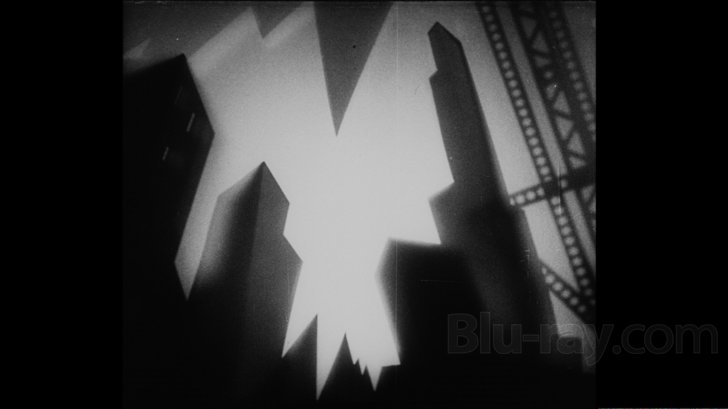
Presented in an aspect ratio of 1.34:1 (with minor fluctuations between different shorts), encoded with MPEG-4 AVC and granted 1080p transfers, Masterworks of American Avant-Garde Experimental Film 1920-1970 arrives on Blu-ray courtesy of Flicker Alley.
The collection features numerous shorts, some of which have been recently restored in 2K. Generally speaking, the quality of the presentations is excellent. Obviously, minor fluctuations in terms of density and depth exist; there are also some minor age-related imperfections, such as tiny print marks, scratches, and vertical lines. However, general image stability, color stability, and contrast and sharpness balance are very good. Grain has also been retained as best as possible. In fact, a number of the early shorts (1920/1930) actually look remarkably good. There are no traces of digital attempts to resharpen and repolish the image. Finally, there are no serious encoding anomalies to report in our review. (Note: This is a Region-Free Blu-ray release. Therefore, you will be able to play it on your player regardless of your geographical location).
Masterworks of American Avant-Garde Experimental Film 1920-1970 Blu-ray Movie, Audio Quality 
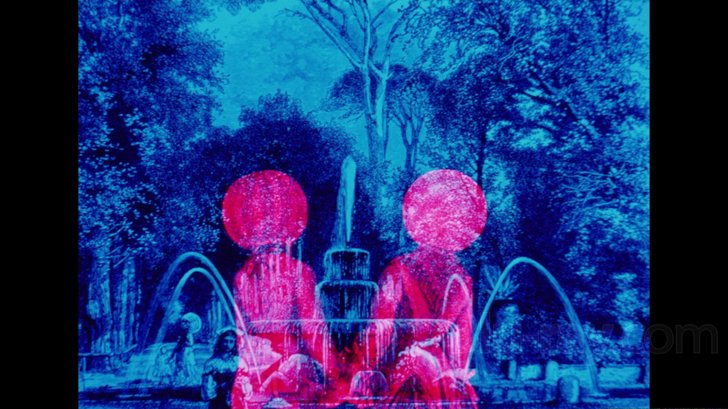
There is only one standard audio track on this Blu-ray release: Music DTS-HD Master Audio 2.0. Some of the short films in the collection come with English intertitles.
The quality of the audio is excellent. Obviously, there is a limited range of nuanced dynamics, but depth is as good as one can expect it to be, especially during the newly recorded music. There are no audio dropout or digital distortions to report in our review.
Masterworks of American Avant-Garde Experimental Film 1920-1970 Blu-ray Movie, Special Features and Extras 
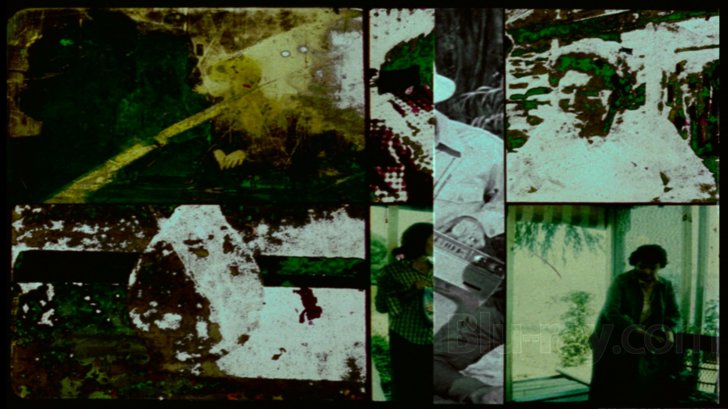
- Bonus Films - the bonus films are listed in the main section of the review.
- Booklet - 28-page illustrated booklet featuring curator, filmmaker, and film historian Bruce Posner's essay "Let the Eyes Have It".
Masterworks of American Avant-Garde Experimental Film 1920-1970 Blu-ray Movie, Overall Score and Recommendation 
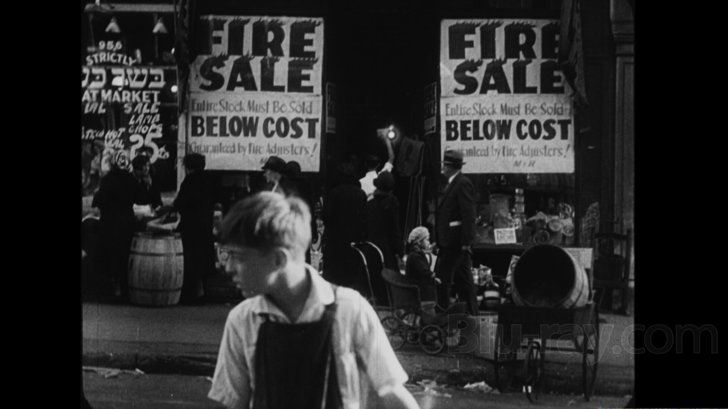
Masterworks of American Avant-Garde Experimental Film 1920-1970 features 37 films from some of the biggest American experimental filmmakers, from Charles Sheeler and Paul Strand to Jonas Mekas and Marie Menken. Many of the films also come with new music scores by acclaimed composers such as Donald Sosin, Gustavo Matamoros, Eric Beheim, and Rodney Sauer. These films have been recently restored and are presented by Flicker Alley and the Blackhawk Films' Collection in cooperation with Filmmakers Showcase. If interested in the history of experimental cinema in America, I urge you to consider adding the two-disc set to your collections because there really isn't another release quite like it on the market. VERY HIGHLY RECOMMENDED.
Similar titles
Similar titles you might also like

Meditation on Violence
1949

At Land
1946

A Study in Choreography for Camera
1945

Ritual in Transfigured Time
1946

Les 3 boutons
2015

T'as de beaux escaliers, tu sais
You've Got Beautiful Stairs, You Know
1986

7 p., cuis., s. de b., ... (à saisir)
1984

Le 15/8
1973

The Private Life of a Cat
1946

Uncle Yanco
Oncle Yanco
1967

Black Panthers
1968

Meshes of the Afternoon
1943

Go West Young Man
1936

Altered Innocence Vol. 2
Slipcover in Original Pressing
2023

The Very Eye of Night
1958

I Cannibali
The Year of the Cannibals
1970

Yum, Yum, Yum! A Taste of Cajun and Creole Cooking
1990

Non, Je Ne Regrette Rien (No Regret)
1993

Gap-Toothed Women
1987

Jinnah
Indicator Series | Limited Edition
1998
